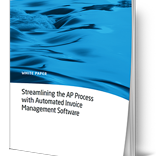Every organisation’s finance team knows that controlling supplier costs is critical. Whether it’s a transportation company that hedges against rising fuel costs, a manufacturer that seeks out supply chain efficiencies to reduce the cost of production, or simply a services organisation that wants to get the best deal on office supplies and travel, streamlining invoices is a critical part of any corporate finance department.
However, one area that many organisations have yet to address is the actual cost of the invoice management and processing function. While of course, the volume of invoices received is dependent on the type of business (for example, a manufacturer will process significantly more invoices than a professional services organisation), one constant is the high cost of moving them through the system. In fact, it’s estimated that for companies with a completely manual process, getting an invoice approved and ready to pay can cost anywhere from 12-17 dollar each. While that may not seem an excessive amount in the grand scheme of running a business, a relatively small organisation that receives just 40 invoices a day will spend more than 125,000 dollar per year simply processing supplier invoices.
Related: How Can Invoice Workflow Automation Work for Your Organisation?
The Problem
The two immediate questions this leads to: why is this process so expensive, and how can it be reduced? The first answer is relatively straightforward: invoice processing can be a very time-consuming and labor-intensive process. Invoices first need to be received and entered into the system (which in itself can lead to huge delays, as supplier invoices may sit for days or weeks’ in recipients’ inboxes before even reaching the AP team). They then need to be coded appropriately, submitted for budget-holder approval and then entered into the ERP system for approval. The opportunity for delays (and also the need for the AP team to chase individuals) at every stage is considerable.
Of course, this assumes a relatively smooth process. The AP team’s lack of visibility into the entire process can lead to a multitude of other potential issues: invoices get lost or forgotten before they even reach AP; delays lead to duplicate invoices being issued and processed; correct approvals processes are bypassed; and so on. While the hard cost of AP’s additional time spent processing these invoices can be clearly identified, there’s the opportunity for several other costs to be introduced as a result: suppliers could impose late-payment fees or interest charges; duplicate invoices could be paid twice; early-payment discount opportunities could be missed.
Related: What Could Manual AP Processes Be Costing Your Organisation?
These are just some of the most tangible financial issues that manual invoice processing presents. Issues such as non-compliance with budget and approval parameters, fraud and incorrect budget allocation may not be as easy to immediately track and calculate, but could lead to major issues in the accounting process.
The Solution
Given the magnitude of challenges that existing manual processes uncover, how can they be resolved? The obvious answer is to automate the process with invoice software. This enables AP departments to streamline the entire process, from electronically capturing the invoices as soon as they are received, to more accurate and compliant budget allocation and faster approval by budget owner. In addition to speeding up the approval process, using invoice management software will also give fully visibility into the process, as well as eliminating issues related to non-compliance by automating business rule enforcement.
Related: Pitching the ROI of AP Automation to Upper Management
The cost savings – just through reduced need for manual intervention – that can be made through invoice automation are clear. According to studies by research firms such as Aberdeen Group and PayStream Advisors, automation can cut the cost of invoice processing buy about 75%. However, these figures don’t take into account the long-term savings and improvements that organizations can realize, from early payment discounts to broader cost savings brought about by more accurate and timely spend data analysis, as well as the more value-added work that AP teams can focus on with the hours that they have been given back.
At a time when the vast majority of business processes have been automated and moved to the cloud, can your organisation afford to process invoices the old way?
Search
Subscribe
Latest Posts
- 9 Signs it’s Time to Switch Expense Management Systems
- Gartner and Ardent Partners Advise How to Build a Best-in-class Accounts Payable Operation
- When Cash (Control) is King: Is Your Accounts Payable Strategy Optimised for a COVID-19 World?
- Getting the Most Out of Your Spend Data with Emburse Insight Advisor
- How We Did It: Supporting Front Line Healthcare Workers During the COVID-19 Outbreak
Posts by Category
Our choice of Chrome River EXPENSE was made in part due to the very user-friendly interface, easy configurability, and the clear commitment to impactful customer service – all aspects in which Chrome River was the clear winner. While Chrome River is not as large as some of the other vendors we considered, we found that to be a benefit and our due diligence showed that it could support us as well as any large players in the space, along with a personalized level of customer care.
We are excited to be able to enforce much more stringent compliance to our expense guidelines and significantly enhance our expense reporting and analytics. By automating these processes, we will be able to free up AP time formerly spent on manual administrative tasks, and enhance the role by being much more strategic.
